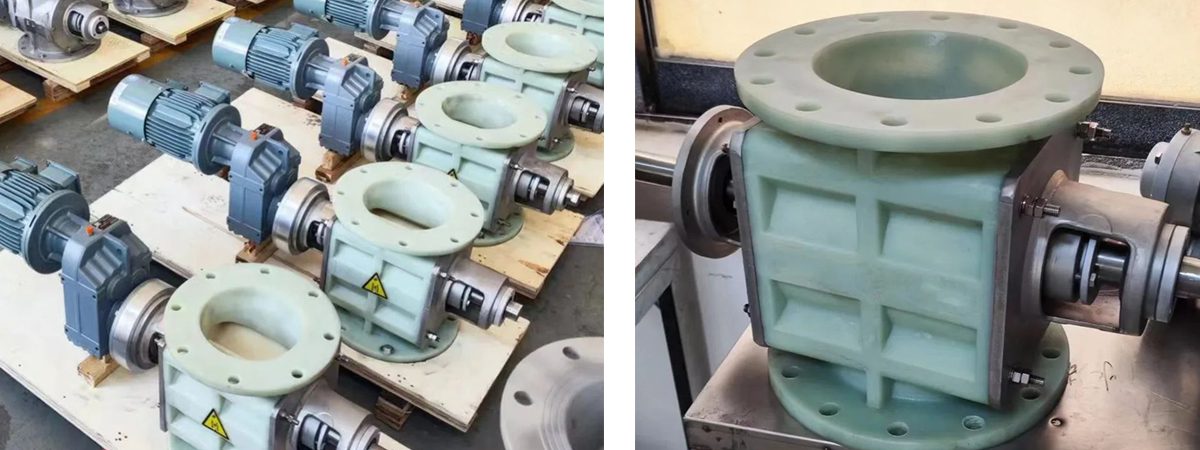Принцип работы поворотных разгрузочных клапанов
Роторные разгрузочные клапаны играют важнейшую роль в пылеулавливающем оборудовании для выгрузки золы, подачи воздуха и питания других устройств. Разгрузочные клапаны в форме звезды особенно подходят для работы с порошкообразными и гранулированными материалами. Вот основные моменты принципа их работы:
1.Пневматическая система вывода: Поворотные разгрузочные клапаны широко используются в пневматических системах вывода. Будь то выход под давлением или вакуумом, звездообразные разгрузочные клапаны обеспечивают стабильную и непрерывную подачу в транспортировочную трубу. Это обеспечивает стабильность газовой и твердой фаз внутри трубопровода, способствуя нормальной работе системы пневмотранспорта. Кроме того, они эффективно изолируют давление между верхней и нижней секциями, выполняя функцию блокировки. Поэтому звездообразные выпускные клапаны являются важнейшими компонентами систем пневмотранспорта.
2.Количественная разрядка: Когда материалы в верхнем бункере падают под действием силы тяжести и заполняют промежутки между лопастями, вращение лопастей выгружает материалы, находящиеся ниже. Это позволяет звездообразным разгрузчикам добиваться количественной и непрерывной разгрузки.
3.Широкое применение: Роторные разгрузочные клапаны могут служить разгрузочными устройствами для бункеров-накопителей, особенно в системах сбора материалов. Являясь передовыми разгрузочными устройствами, звездообразные разгрузочные клапаны играют важную роль в системах пылеудаления. Они находят применение в таких отраслях, как защита окружающей среды, металлургия, химическая промышленность, пищевая промышленность, производство цемента, дорожное строительство и сушильное оборудование.
4.Устойчивость к высоким температурам: Стандартные вращающиеся разгрузочные клапаны могут работать с материалами температурой до 280°C. Их подшипники и крыльчатки изолированы, что предотвращает контакт между порошком и подшипниками. Высокотемпературные разгрузочные клапаны могут работать с материалами до 500°C и используют цепные соединения.
Структура поворотных разгрузочных клапанов
Роторные разгрузочные клапаны обычно состоят из нескольких частей:
1.Корпус клапана: Корпус клапана - это основной компонент, обычно изготовленный из чугуна или нержавеющей стали. Форма и расположение внутренних проходов определяют область применения и производительность клапана.
2.Ротор: Ротор - это ключевой компонент, включающий в себя сердечник клапана, вал клапана и клапан. Сердечник вращается внутри корпуса, изменяя направление потока и открывая или закрывая трубопровод.
3.Уплотнительные элементы: Уплотнения работают между ротором и корпусом клапана, предотвращая утечку жидкости. Обычные материалы для уплотнений включают резину, PTFE и металл.
4.Механизм привода: Этот механизм приводит в действие ротор и может включать маховики, электродвигатели или пневматические приводы.
5.Аксессуары: Такие аксессуары, как предохранительные клапаны, выпускные клапаны и запорные устройства, повышают безопасность и удобство использования поворотных клапанов.
Методы обслуживания поворотных разгрузочных клапанов
В заводских условиях оборудование может столкнуться с проблемами в процессе эксплуатации. Разгрузочные устройства, являясь широко распространенным продуктом, могут столкнуться с различными проблемами. Вот несколько советов по обслуживанию и ремонту:
1.Регулярно проверяйте смазку: Разгрузочные устройства поставляются с завода заправленными смазочными материалами и консистентной смазкой. Во время работы регулярно проверяйте смазочное масло, особенно в условиях высокой температуры или запыленности. Сократите интервал замены масла, чтобы предотвратить повреждения.
2.Адрес Утечка воздуха и пыли: Если во время работы происходит утечка воздуха или пыли вдоль оси, подтяните винты на прижимной крышке. В качестве альтернативы замените сальник и снова закрепите крышку.
3.Следуйте процедурам разборки: Внутренняя структура различных моделей схожа, и процессы разборки и сборки в целом одинаковы. Во время транспортировки держите устройство в устойчивом положении, чтобы избежать ударов, которые могут повредить корпус или двигатель.
4.Самодиагностика неисправностей: Когда возникают проблемы из-за недостаточного обслуживания, пользователи должны научиться самостоятельно диагностировать неисправности, чтобы повысить эффективность работы.
- Неправильное использование и неточная работа могут повредить двигатель. Всегда следуйте указаниям по правильному использованию.
- Периодически проверяйте систему управления очисткой, чтобы убедиться в правильности циклов очистки. Проверьте реле давления и прочистите любые засоры в местах измерения давления.
- Регулярно измеряйте такие параметры процесса, как объем газа, температура и концентрация. Незамедлительно исследуйте и устраняйте любые аномалии.
- Когда разгрузочный клапан остановится, продолжайте работать разгрузочным клапаном и вытяжным вентилятором некоторое время, чтобы удалить влагу и пыль из оборудования. Может потребоваться ручная очистка, чтобы предотвратить воздействие влаги на фильтрующие мешки.

Соблюдая эти правила обслуживания, пользователи смогут продлить срок службы поворотных разгрузочных клапанов и обеспечить их надежную работу в различных промышленных приложениях.
Для получения дополнительной информации или поддержки, пожалуйста, не стесняйтесь связаться с нами. Мы готовы предоставить Вам профессиональные советы и решения.

